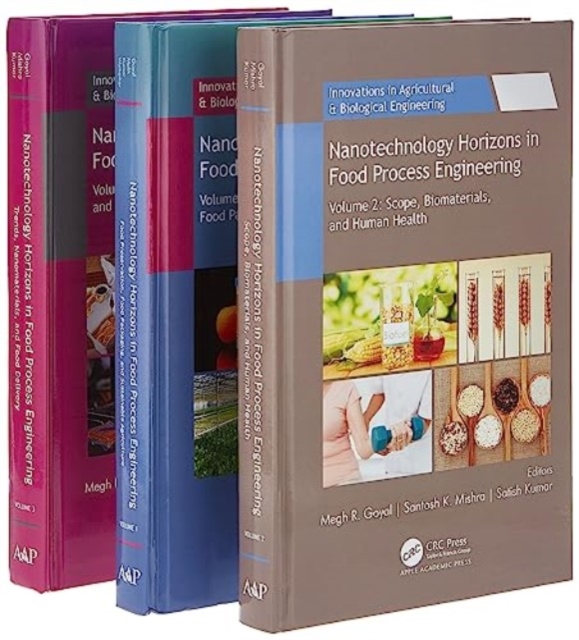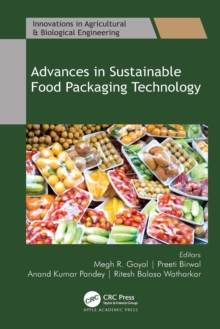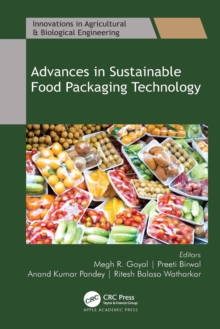
Nanotechnology Horizons in Food Process Engineering : 3-volume set Multiple-component retail product
Edited by Megh R. Goyal
Part of the Innovations in Agricultural & Biological Engineering series
Multiple-component retail product
- Information
Description
Although nanotechnology has revolutionized fields such as medicine, genetics, biology, bioengineering, mechanics, and chemistry, its increasing application in the food industry is relatively recent in comparison.
Nanotechnology is being used to discover new methods for creating new flavors, extending food shelf life, and improving food protection and nutritional value.
Nanotechnology in the food industry is now being explored for intelligent nutrient delivery systems, "smart" foods, contaminant detection nanodevices and nanosensors, advanced food processing, antimicrobial chemicals, encapsulation, and green nanomaterials. This new three-volume set, Nanotechnology Horizons in Food Process Engineering, addresses a multitude of topical issues and new developments in the field.
Volume 1 focuses food preservation, food packaging and sustainable agriculture, while Volume 2 looks at nanotechnology in food process engineering, applications of biomaterials in food products, and the use of modern nanotechnology for human health.
The third volume explores the newest trends in nanotechnology for food applications and their application for improving food delivery systems.
Together, these three volumes provide a comprehensive and in-depth look at the emerging status of nanotechnology in the food processing industry, explaining the benefits and drawbacks of various methodologies that will aid in the improvement and development of food product sourcing and food hygiene monitoring methods. Volume 1 discusses emerging nanotechnolgical applications in food processing, packaging, and preservation.
It focuses on using nanoparticles for safe and nutritional food production, protecting crops from pests, increasing nutritional value, and providing solutions for various environmental issues.
This book especially deals with nanotechnology for controlling plant pathogens, food packaging and preservation, agricultural productivity, wastewater treatment, and bioenergy production. Volume 2 discusses nanotechnology use in non-thermal techniques such as high-pressure processing (HPP), pulsed electric fields (PEFs), pulsed light, ultraviolet, microwave, ohmic heating, electrospinning, and nano- and microencapsulation.
This volume looks at the role and application of minimal processing techniques such as ozone treatment, vacuum drying, osmotic dehydration, dense phase carbon dioxide treatment, and high-pressure assisted freezing.
The successful applications of nanotechnologies on juices, meat and fish, fruits and vegetable slices, food surface, purees, milk and milk products, extraction, drying enhancement, and encapsulation of micro-macro nutrients are also considered.
The volume also presents several computer-aided techniques that are emerging in the food processing sector, such as robotics, radio frequency identification (RFID), three-dimensional food printing, artificial intelligence, etc.
Significant role of food properties in design of specific food and edible packaging films have been elucidated. Volume 3: Trends, Nanomaterials and Food Delivery provides an overview of the current trends in nanotechnology for food applications and food delivery systems.
Topics include a collection of chapters on diverse topics, including the stability of nanoparticles in food, nanobiosensing for the detection of food contaminants, nanotechnology applications in agriculture, the role of nanotechnology in nutrient delivery, how nanotechnology is applied in dairy products, biofunctional magnetic nanoparticles in food safety, the development of nutraceuticals using nanotechnological tools, and more.
Information
-
Out of StockMore expected soonContact us for further information
- Format:Multiple-component retail product
- Pages:1206 pages, 67 Illustrations, color; 39 Illustrations, black and white
- Publisher:Apple Academic Press Inc.
- Publication Date:10/03/2023
- Category:
- ISBN:9781774910641
£385.00
£317.52
Information
-
Out of StockMore expected soonContact us for further information
- Format:Multiple-component retail product
- Pages:1206 pages, 67 Illustrations, color; 39 Illustrations, black and white
- Publisher:Apple Academic Press Inc.
- Publication Date:10/03/2023
- Category:
- ISBN:9781774910641



